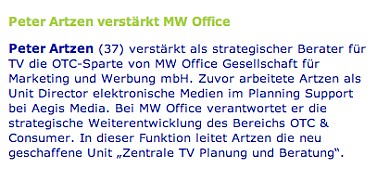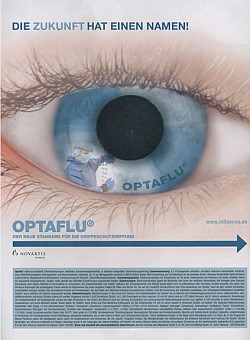| Autor: strappato 2007-10-08 Link (1 Kommentar) Ihr Kommentar |
Beeindruckende Referenzen
Peter Rosts Thriller, um die kriminelle Pharmabranche habe ich fast gelesen. Diese Meldung, die mich per E-Mail erreichte, lässt mich an der Grenze Fiktion-Realität zweifeln.

Der neue OTC-TV-Leiter kommt von Aegis Media, die in einen der grössten Skandale der Werbewirtschaft verwickelt ist. Der ehemalige Chef sitzt seit 11 Monaten in Untersuchungshaft. Neben dem Vorwurf, Millionen in eigene Taschen an der Steuer vorbei gewirtschaftet zu haben, ist das "System Aegis Media" interessant, wie es der Ex-CEO in einem Interview aus dem Knast erklärt.
Also haben wir Kundengeld investiert, um an Informationen zu gelangen. Auf völlig legalem Weg. Leute, die gerne reden wollten, haben wir reden lassen. In angenehmer privater Atmosphäre. Noch ein Beispiel: Den Geschäftsführer von BMW Österreich hatte ich lange versucht, persönlich zu treffen, obwohl er nicht Kunde von Aegis war. Ich traf ihn schließlich beim Verleih eines Autopreises in Wien. Als klar war, dass er auch Jäger war, habe ich ihn zur Hirschjagd eingeladen. Und schon haben wir den ganzen Abend miteinander sprechen können. Natürlich nicht nur über Rotwild, sondern auch übers Geschäft.
...
Wir haben einen legalen Weg mit Kundengeldern gefunden, wie wir Kundenvorteile und Aegis Media-Vorteile generieren. Aegis hat inzwischen auch bestätigt, dass es dieses System gab und alle davon wussten.
...
Wir haben einen legalen Weg mit Kundengeldern gefunden, wie wir Kundenvorteile und Aegis Media-Vorteile generieren. Aegis hat inzwischen auch bestätigt, dass es dieses System gab und alle davon wussten.
Erstklassige Referenzen für die Pharmabranche.
[Pharmamarketing]
| Autor: strappato 2007-09-18 Link (0 Kommentare) Ihr Kommentar |
Augen auf bei Pharmaanzeigen

Das ist keine Anzeige für das Novartis-Produkt Lucentis®, sondern soll bei den Ärzten den Umsatz des neuen Grippeimpfstoffs Optaflu® von Novartis steigern.
In der Art Director-Schule würde man sagen: "Thema verfehlt, 6, setzen". In der Pharmawerbung schafft sowas die Ehrung zur Die beste Pharmaanzeige des Monats August 2007.
[Pharmamarketing]
| Autor: strappato 2007-09-17 Link (0 Kommentare) Ihr Kommentar |
Grippevirus goes viral (update)
Novartis versucht es mit user-generated, viralen Marketing. Auf youtube ruft der Pharmakonzern zu einem video-contest auf. Für den besten Gripppe-Clip in den Kategorien "Kinder und Grippe", "Sport und Grippe" und "Arbeit und Grippe" gibt es jeweils $ 500 Euro.
Spannend könnten die Regeln sein. Die Internetseite liefert aber nur Fehlermeldungen.
[via BrandweekNRX]
--
Update
Es sind die "Terms & Conditions zumindest bei youtube online. Mitmachen können nur US-residents. Alles was vom Sponsor als verächtlich aufgefasst wird, fliegt raus. Mal sehen, ob da noch viel übrig bleibt.
[Pharmamarketing]
| Autor: strappato 2007-09-05 Link (2 Kommentare) Ihr Kommentar |
Pharmaanzeigen
Wer immer schon einmal in die Untiefen der Pharmawerbung für Fachkreise blicken wollte, dem empfehle ich die Internetseite: Die beste Pharmaanzeige.
Die Werbeagentur WEFRA stellt jeden Monat 5 Pharma-Anzeigen zur Auswahl und lässt den Nutzer entscheiden, welche der vorgestellten Anzeigen ihm am Besten gefällt.
Achtung: Auf eigene Gefahr. Für Risiken und Nebenwirkungen für den Geschmack hafte ich nicht. Genau wie der Leser dieses blogs, der mich auf die Internetseite hingewiesen hat.
[Pharmamarketing]
| Autor: strappato 2007-08-15 Link (0 Kommentare) Ihr Kommentar |
Bayer lässt sich Kommunikation was kosten
In dem Programm für gesetzmäßiges und verantwortungsbewusstes Handeln verspricht der Pharmakonzern Bayer:
Bayer ist bestrebt, mit allen zuständigen Behörden ein kooperatives, offenes Verhältnis herzustellen und zu erhalten. Die Sicherung der Rechte des Unternehmens und seiner Mitarbeiter in Fällen behördlicher Ermittlungen steht hierzu nicht im Widerspruch.
Bayer nimmt dies ernst. Das kann man daran erkennen, dass der Konzern im ersten halben Jahr 2007 nach einer Meldung der Nachrichtenagentur ap für die Herstellung eines kooperativen Verhaltnisses in den USA mehr als $ 2 Milionen für das Lobbying beim US-Kongress und der US-Regierung ausgegeben haben soll.
[Pharmamarketing]
| Autor: strappato 2007-08-15 Link (0 Kommentare) Ihr Kommentar |
Wüstenwunder Umckaloabo
Bei der Recherche für den
Es ein Schnelldreher in den Apotheken mit einem Umsatz von mehr als 80 Millionen Euro und das eines der erfolgreichsten rezeptfreien Präparate in Deutschland. Der Hersteller Spitzner Arzneimittel und Vertriebschef Traugott Ulrich haben von Anfang an voll auf Marketing gesetzt. Jedoch nicht traditionelle Formate, sondern ausnahmslos auf Advertorials und Schleichwerbung, sogenannte Sonderwerbeformen. Dafür gibt das Unternehmen jährlich mindestens 8 Millionen Euro aus, nach der
Auch Traugott Ullrich textet Advertorials selbst und schert sich nicht um gängige Regeln.
Traugott Ulrich hatte vor zwei Jahren noch die Kooperation mit Sat 1 dementiert, es langte dennoch zu einer Rüge des Deutsche Rats für Public Relations gegen die vermittelnde PR-Agentur Connect-TV. Übrigens zusammen mit dem ebenfalls durch unerlaubte Werbeformen
Zum Nutzen des Mittels stellte das arzneimittel-telegramm 2003 fest:
Ein Nutzen des Pelargonium-Extrakts UMCKALOABO, der als "pflanzliches Antibiotikum" insbesondere bei Atemwegsinfektionen angeboten und beworben wird, ist nicht nachgewiesen.
...
Wir raten von der Anwendung des unzureichend dokumentierten Produktes ab. Ob die noch ausstehende Nachzulassung dem Mittel ein Ende bereitet?
2005 hat das Medikament vom BfArM die Nachzulassung erhalten, jedoch nur für die Indikation "akute Bronchitis". Es wird aber immer noch in den Medien allgemein für Erkältungen und Schnupfen empfohlen. Auch ein Erfolg des aggressiven Marketings....
Wir raten von der Anwendung des unzureichend dokumentierten Produktes ab. Ob die noch ausstehende Nachzulassung dem Mittel ein Ende bereitet?
Der Pflichttext "Zu Risiken und Nebenwirkungen lesen Sie die Packungsbeilage und fragen Sie Ihren Arzt oder Apotheker" entfällt bei Advertorials und ist quasi überflüssig, da im Internet ein separater Bereich mit speziellen Informationen für Fachkreise bei umckaloabo.de fehlt. Obwohl vor 3 Jahren angekündigt. Der Arzt oder Apotheker weiss im Zweifelsfall nicht mehr als der Patient, oder kennt nur die Erfolgsmeldungen aus der Ärzte Zeitung.
Noch ein paar Highlights aus dem Umckaloabo-Marketing:
- Ein kürzlich erschienenes Supplement der Zeitschrift "Phytomedicine", das ausschliesslich Umckaloabo behandelt. Supplements werden dem Verlag vom Hersteller bezahlt.
- Der Hubert Burda Health Lunch im Jahr 2005 zur "Antibiotika Resistenz" mit Traugott Ulrich. Antibiotika Resistenz ist ein immer wiederkehrendes Thema für das Umckaloabo-Marketing und Ulrichs Arbeitgeber Spitzner ein guter Anzeigenkunde von Burda. Etwa in Fit For Fun (Bild 4) oder bei Focus.
- Ein Film über die "Heilkraft aus der Wüste", der 2005 erstmals von 3sat ausgestrahlt worden ist und in dem Umckaloabo eine herausragende Rolle einnimmt.
- Keine Nebenwirkungen
- Erfolgsgarantie
- Vielseitig wirksam
- Exotische Herkunft
- Besser als die Schulmedizin
- Seit Jahrzehnten bewährt
- In Indikationen wirksam, für die es keine Zulassung/Studien gibt
[Pharmamarketing]
| Autor: strappato 2007-08-08 Link (9 Kommentare) Ihr Kommentar |
Reform-Manifesto
Bevor Jim Edwards, Wirtschaftsjournalist bei Brandweek, ein Fellowship an der Columbia Universität antreten wird, hat er sich in seinem letzten posting im blog BrandweekNRX Gedanken über das Pharmamarketing gemacht und eine Liste mit 10 Punkten veröffentlicht.
10 Reforms That Drug Advertising Needs Right Now
- In TV ads for drugs, the FDA should ban disjointed imagery during side-effect warnings: One of the more compelling parts of the FDA’s review process was the presentation by Ruth Day of Duke University. She did a study showing that when drug ads listed benefits, the images on the screen matched the voiceover and moved slowly. But when side effects were listed, the images often became mis-matched to the voiceover and moved much faster or were more distracting. The result is that viewers find it more difficult to remember the side effects than the benefits. (See her presentation here.) Once you know this, you’ll notice that this is a frequent aspect of drug advertising – as soon as they get to the bad stuff spots devolve into an avalanche of unrelated imagery.
- Reminder ads should be illegal: Promoting a drug but not saying what it does or what its disadvantages could be? This helps neither the patient nor the doctor. The only health issue it promotes is drug companies’ bottom lines.
- Product placement should be illegal, paid or unpaid: A product placement is essentially a sophisticated reminder ad (see above) and should be treated as such. When will the FDA wake up to this issue?
- Drug company PR people should be properly trained to answer straight questions with straight answers: Here’s how the current kabuki show works: a reporter (or a blogger) calls up a drug company with legit questions about one its products. The pr person then asks for the questions to be submitted via email. The reporter submits a list of questions. The pr people ignore them. A day or so later (why does everything take more than 24 hours at drug companies? This isn’t the 19th Century!) the pr person sends an email to the reporter containing a single statement that fails to address the list of questions that the company asked to see, and often doesn’t really address the issue at stake. If changing this means firing traditional PR staff and replacing them with medical science liaison staff trained in pr skills, then so be it. But for the official spokespersons of drug companies to be unable or unwilling to talk in detail about their products indicates either ignorance or incompetence or, just as bad, lack of transparency.
- Pharma companies should be required by the SEC to break out their promotional costs: Currently, drug companies don’t have to say anything about how much they spend promoting drugs. They mix those numbers in with their selling, general and admin budget line. They do break out their R&D costs. But for some reason their promo costs remain a mystery. This is because marketing costs tend to be roughly double R&D costs. PhRMA frequently bleats that new drugs cost in excess of $800 million to develop. Give them the benefit of the doubt – but remember that such a drug will burn through $1.6 billion in ads, sales rep salaries and CME grants across its lifetime. Who ultimately pays for that? Consumers and taxpayers. Asking for transparency on this is not burdensome. Bristol Myers Squibb already does it in part (although I’d like to see something a little more detailed.)
- FDA should require relevant head-to-head studies for second-to-market drugs: If companies want to launch a new brand, they currently have to prove to the FDA that the drug is both effective and safe. But they don’t necessarily have to provide data about the drug’s effectiveness or safety as compared to its key competitors in the market. Rather, new drug studies are often based on older, generic or less sophisticated drugs on the market. This is why doctors in crucial areas of practice – such as cancer – still lack evidence of whether Femara is more effective, and under what circumstances, than Arimidex. Neither AstraZeneca nor Novartis has dared to study both drugs against each other, even though they both treat the same thing. What does this have to do with advertising? Ads tend to be based on claims for the drug, but currently most DTC is laughably vague. “Take control of your life,” “Take action,” “Now you can do something about it,” and so on. If there were head-to-head studies on record with the FDA you’d soon see DTC advertising become a lot more specific about whose drugs are safer and whose are more effective. And we wouldn’t have fiascos such as this one, where doctors weren’t recommending certain cancer drugs because they weren’t being paid enough to administer them.
- FDA-mandated transparency in Continuing Medical Education: Drug companies should have to report into a web-based form on the FDA’s web site the total amount of money they spend on CME, which companies they funded to provide it, and which categories they provided CME funding in, with each entry broken into dollars. Then, once a year, companies should have to file a PDF detailing every single CME payment they made to every single CME company, broken down by dollars, purpose, event and date. Medical education should no longer be like the Wizard of Oz sitting behind the curtain. Companies should have the right to educate doctors about anything they want, but there should be full transparency about it.
- FDA-mandated transparency in grants and donations for non-profit groups: Again, as above, drug companies should have to properly report in detail who they funded, how much they funded and when they funded, on a single public web site. That will allow patients and doctors to more objectively evaluate the statements of various pressure groups on health issues. Ever wondered why Planned Parenthood was so gung-ho about hormonal contraception? Could it be because the Robert Wood Johnson Foundation, funded by J&J stock, is a major donator to its various affiliates? (Here’s just one of many.)
- FDA mandated transparency for payments and gifts to doctors: The laws of Minnesota and Vermont, which require all drug company payments and gifts to individual doctors be recorded and made transparent, should be adopted nationally. The public has a legitimate interest in knowing whether doctors are speaking as objective experts or as paid sock puppets. So many doctors make it into media coverage because their expertise has been leavened by consultancy fees on the very issue they’re being asked to comment neutrally upon.
- FDA mandated transparency in prescription-writing habits: Some doctors have gotten annoyed at the fact that sales reps can check scrip databases and find out how much of each drug they write. Reps often know more about doctors’ scrip habits than doctors do. The doctors are wrong on this issue. In just the same way that the public should be able to see which doctors are on pharma payrolls, there’s an obvious public interest in being able to see whether doctors prescription habits correlate with the payments they’ve received from drug companies.
Die Reformpunkte beziehen sich auf den US-Markt, einige Dinge treffen auf Deutschland und Europa nicht zu, jedoch sollte man im Hinterkopf haben, dass die Pharmaindustrie gegen unsere Werbeeinschränkungen zu Felde zieht und amerikanische Verhältnisse sich wünscht - im Namen der Patientenautonomie.
Die meisten angesprochenen Reformvorschläge würden auch hierzulande dringend nötig sein. Sie betreffen die Datensammlung auf dessen Basis der Pharmaaussendienst erfolgsabhängig honoriert wird, Transparenz bei den Leistungen der Pharmaunternehmen an Ärzte - für Vorträge oder gesponserte Fortbildungen, Transparenz bei den Spenden an Verbände und Selbsthilfegruppen, direkte Vergleichsstudien (head-to-head trials) statt Placebo-Vergleiche, Veröffentlichung der Marketingaufwendungen, bessere Kommunikation.
Ich denke, dass relevante Dinge angesprochen werden, die mit für das schlechte Image der Pharmaindustrie bei Politik, Ärzten und Patienten verantwortlich sind. Nur glaube ich nicht, dass sich was ändern wird.
--
In amerikanischen Pharmablogs wird spekuliert, dass der Nachfolger von Jim Edwards bei brandweekNRX kein Geringerer als Peter Rost sein wird. Peter Rost hatte in seinem blog schon vorangegangene Woche über einen Job als Journalist bei einen "real magazine" berichtet.
[Pharmamarketing]
| Autor: strappato 2007-07-31 Link (0 Kommentare) Ihr Kommentar |
Product Placement
In den USA wird nicht nur für verschreibungspflichtige Medikamente geworben, auch das Product Placement in TV-Sendungen ist beliebt. Im letzten Jahr zählte Nielsen 462 Erwähnungen, mehr als doppelt soviele, wie 2004.
[Pharmamarketing]
| Autor: strappato 2007-07-30 Link (0 Kommentare) Ihr Kommentar |
Big Bucks, Big Pharma (Upadate)
"Big Bucks, Big Pharma - Marketing disease and pushing drugs", die Dokumentation über das Pharmamarketing in den USA ist in voller Länge bei googlevideo zu sehen.
Featuring interviews with Dr. Marcia Angell (Dept. of Social Medicine, Harvard Medical School; Former Editor New England Journal of Medicine), Dr. Bob Goodman (Columbia University Medical Center; Founder, No Free Lunch), Gene Carbona (Former Pharmaceutical Industry Insider and Current Executive Director of Sales, The Medical Letter), Katharine Greider (Journalist; Author, The Big Fix: How the Pharmaceutical Industry Rips Off American Consumers,), Dr. Elizabeth Preston (Dept. of Communication, Westfield State College), and Dr. Larry Sasich (Public Citizen Health Research Group)
--
Update
Das "Prescription Access Litigation (PAL) Project" hat die DTC (Direct-to-Consumer) Werbeausgaben veröffentlicht. In den USA gaben die Pharmakonzerne im Jahr 2006 $ 4,8 Milliarden für TV-Spots, Anzeigen, usw.) aus. Alleine für die 3 umsatzstärksten verschreibungspflichtigen Medikamente (Lipitor, Nexium, Advair) wurden $ 460 Millionen in die DTC-Werbung gesteckt.
[Pharmamarketing]
| Autor: strappato 2007-07-30 Link (1 Kommentar) Ihr Kommentar |

Sorry, you need system administrator rights for that.
